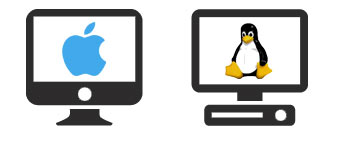

use nomodeset) Alternatively, burning a CD and installing via an external CD-drive will work fine on the Macbook Air 3,2. (Here you might want to press F6 to change parameters, e.g. Next, set the new MAC using command: sudo ip link set dev enp0s31f6 address XX:XX:XX:XX:XX:XX. First, turn off the network card using command: sudo ip link set dev enp0s31f6 down.
#Can you put linux on a mac install#
Select Pingo/Windows logo: Install should start. I would recommend using Macchanger but if you don’t want to use it, there is another way to change the MAC address in Linux.
#Can you put linux on a mac mac os#
Is it tremendously "techy" to do (something I am not - even Hackintoshes scare me right now).Īlso, is there any software like Parallels desktop, but for running Mac OS on a PC? Something off the shelf, that works well, and is reliable? dd the whole USB stick to that partition. So what are the downsides? Because it seems like a really viable option right now. You can put an Nvidia 2080ti in there, as well as a Ryzen CPU, and it will work. Linux is incredibly versatile (it’s used to run everything from smartphones to supercomputers), and you can install it on your MacBook Pro, iMac, or even your Mac mini.

why would you build a Hackintosh if this is an option? I realise there's a few % of performance loss, BUT you aren't limited in component choice. Whether you need a customizable operating system or a better environment for software development, you can get it by dual booting Linux on your Mac. This command will list network interface name,Ip address, MTU size, etc. The number next to ether is the MAC address. All we need is to open the terminal then type ifconfig -a in the prompt. It's basically like running Parallels desktop, but instead of running it on a Mac to allow you to use Windows, you run Mac OS on your windows PC.įor anyone not familiar with the concept, this is what I'm talking about. The best Linux command to find MAC address is using ifconfig command. In the process of researching Hackintosh's, I came across the concept of Virtualisation (Virtual Machines). It seems like there's been some advances since you last checked.? Maybe you're talking about how Virtualisation used to be. EDIT: For everyone saying things like "it's slow", or "there's no Hardware Acceleration" etc, are you sure? Watch the video below from 14:45 on.


 0 kommentar(er)
0 kommentar(er)
